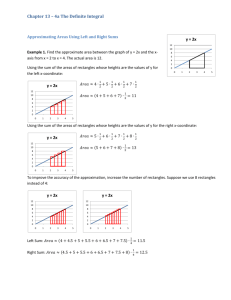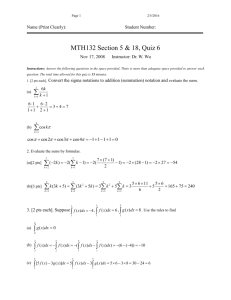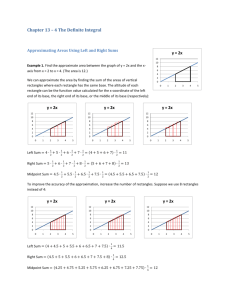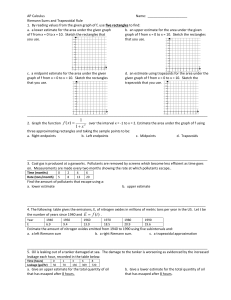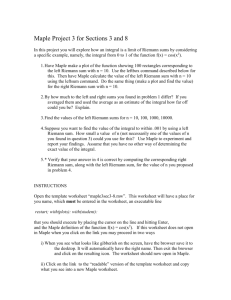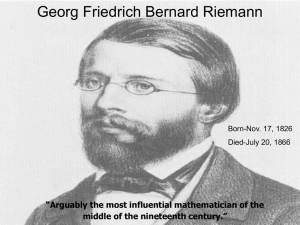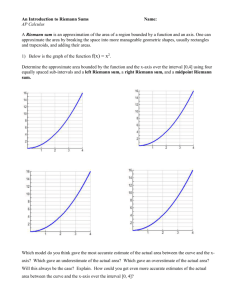Riemann Sums - middletownhighschool
advertisement
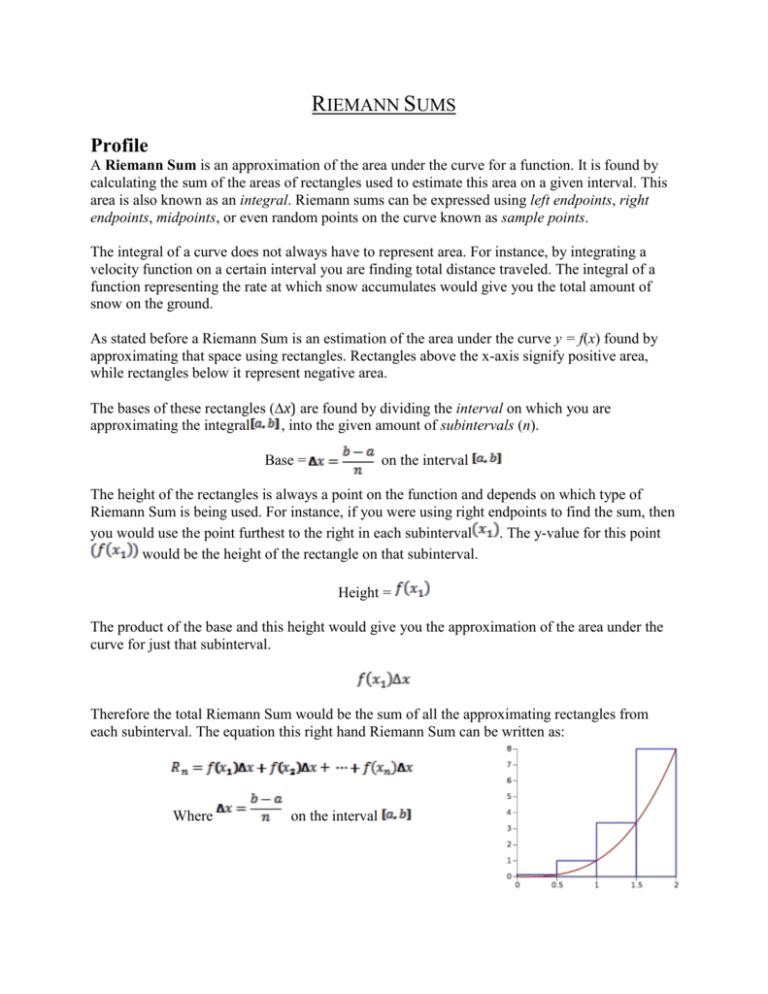
RIEMANN SUMS Profile A Riemann Sum is an approximation of the area under the curve for a function. It is found by calculating the sum of the areas of rectangles used to estimate this area on a given interval. This area is also known as an integral. Riemann sums can be expressed using left endpoints, right endpoints, midpoints, or even random points on the curve known as sample points. The integral of a curve does not always have to represent area. For instance, by integrating a velocity function on a certain interval you are finding total distance traveled. The integral of a function representing the rate at which snow accumulates would give you the total amount of snow on the ground. As stated before a Riemann Sum is an estimation of the area under the curve y = f(x) found by approximating that space using rectangles. Rectangles above the x-axis signify positive area, while rectangles below it represent negative area. The bases of these rectangles (∆x) are found by dividing the interval on which you are approximating the integral , into the given amount of subintervals (n). Base = on the interval The height of the rectangles is always a point on the function and depends on which type of Riemann Sum is being used. For instance, if you were using right endpoints to find the sum, then you would use the point furthest to the right in each subinterval . The y-value for this point would be the height of the rectangle on that subinterval. Height = The product of the base and this height would give you the approximation of the area under the curve for just that subinterval. Therefore the total Riemann Sum would be the sum of all the approximating rectangles from each subinterval. The equation this right hand Riemann Sum can be written as: Where on the interval Sigma notation is often used to write these sums more efficiently. For example: Where Therefore using sigma notation the left endpoint, right endpoint, midpoint, and sample point Riemann sums can be written as: Where Where is any number in the ith subinterval The Trapezoidal Rule and Simpson’s Rule more accurately estimate the integral of function. The Trapezoidal Rule uses trapezoids rather than rectangles to approximate the area much more accurately. Simpson’s Rule uses parabolas to approximate the integral even better than the Trapezoidal Rule can. The Riemann integral of a function, also known as a definite integral, can be found by calculating the limit as the number of these approximating rectangles approaches infinity giving a definite integral rather than just an approximation. As shown by the equation: Examples Ex. 1) Approximate the integral of Riemann Sum. Ex. 2) Approximate the integral of Sum. on the interval on the interval using the left endpoint using the midpoint Riemann Ex. 3) Evaluate using the Riemann integral Click here for an example of the Trapezoidal Rule Click here for an example of Simpson’s Rule Applications Since Riemann sums and the Riemann integral are both ways of integrating, they can be used almost anywhere you are calculating or approximating an integral. The most common application of Riemann sums is in approximating area, usually where a function cannot be made to represent the data being integrated in order to find the area underneath. For example, if you were making a patio along your house with curved edges that were not easily represented by a function, you could use Riemann sums to estimate the area of the patio in order to buy the right amount of gravel to lay out for the base. They also have applications in exports and population growth. The Riemann integral or definite integral can also be used to calculate the areas of surfaces of revolution, where a curve is rotated around an axis. History Both Riemann sums and the Riemann integral were developed and named after the German Mathematician, Bernhard Riemann. Georg Friedrich Bernhard Riemann (1826-1866) studied under Carl Gauss at the University of Gottingen and eventually taught there himself. He showed great skill in mathematics that was noted by many including Gauss who described his “creative, active, truly mathematical mind and gloriously fertile originality”. Thanks to his work integration was first “rigorously formalized”. His Riemann integral, that uses limits and his Riemann sums, is still used today to define a definite integral. In addition to Integration, he made advances in the theory of functions of a complex variable, mathematical physics, number theory, the foundations of geometry and the basis for Einstein’s theory of relativity. Most important, due to Riemann we now have an extremely confusing way of merely approximating an integral. http://en.wikipedia.org/wiki/List_of_topics_named_after_Bernhard_Riemann Profile http://science.kennesaw.edu/~plaval/applets/Riemann.html http://www.cut-the-knot.org/Curriculum/Calculus/RiemannSums.shtml http://mathworld.wolfram.com/RiemannSum.html http://en.wikipedia.org/wiki/Riemann_sum http://archives.math.utk.edu/visual.calculus/4/riemann_sums.4/ http://www.math.hmc.edu/calculus/tutorials/riemann_sums/ http://calculusapplets.com/riemann.html http://www.msstate.edu/dept/abelc/math/integrals.html http://www.analyzemath.com/calculus/RiemannSums/RiemannSums.html http://en.wikipedia.org/wiki/Riemann_integral http://archives.math.utk.edu/visual.calculus/4/definite.1/index.html http://www.intmath.com/Integration/5_Trapezoidal-rule.php http://www.intmath.com/Integration/6_Simpsons-rule.php http://integrals.wolfram.com/index.jsp Videos http://www.teachertube.com/viewVideo.php?video_id=71388&title=Riemann_Sums&vpkey= http://www.youtube.com/watch?v=gFpHHTxsDkI http://www.youtube.com/watch?v=GE4OLfmJ8P8 http://www.youtube.com/watch?v=xdXW-V0Q7xA http://www.youtube.com/watch?v=t48qM0vEXJE&annotation_id=annotation_927406&feature= iv Applications http://www.usna.edu/MathDept/website/courses/calc_labs/area/Application.html http://curvebank.calstatela.edu/arearev/arearev.htm http://upload.wikimedia.org/wikipedia/commons/1/19/Riemann_sum_%28leftbox%29.gif http://upload.wikimedia.org/wikipedia/commons/6/61/Riemann_sum_%28rightbox%29.gif http://upload.wikimedia.org/wikipedia/commons/c/c3/Riemann_sum_%28middlebox%29.gif http://upload.wikimedia.org/wikipedia/commons/e/ee/Riemann.gif http://www.cut-the-knot.org/Curriculum/Calculus/RiemannSums.shtml http://archives.math.utk.edu/visual.calculus/4/definite.2/index.html
